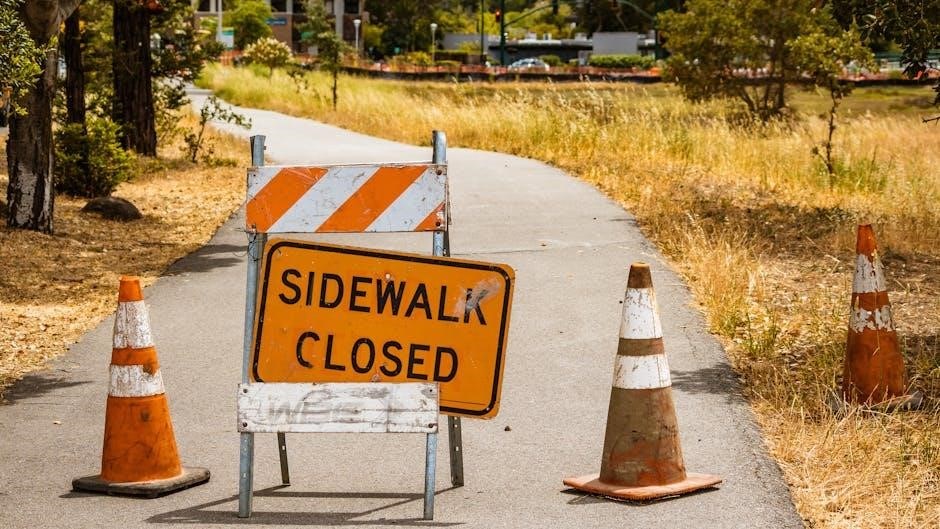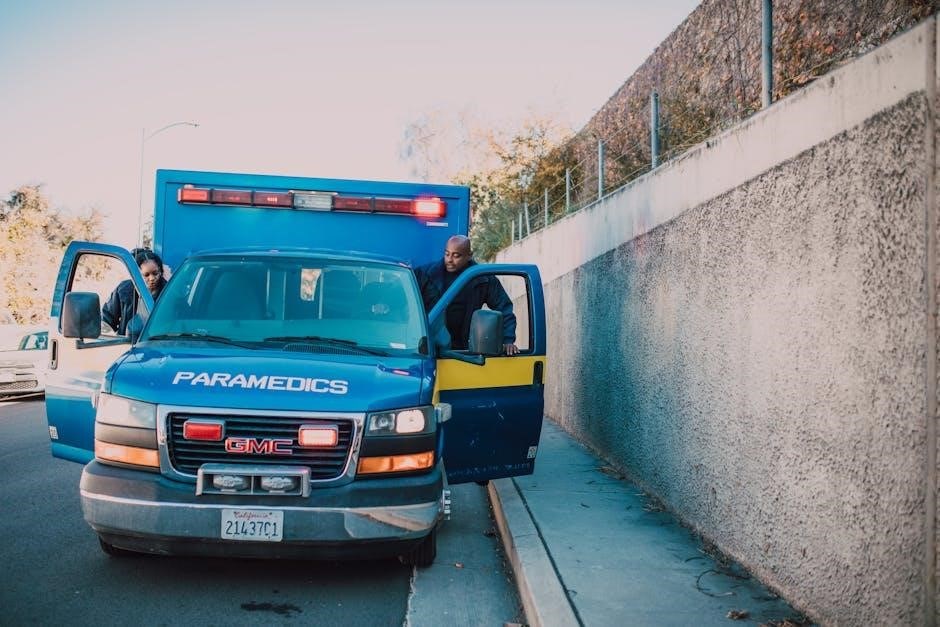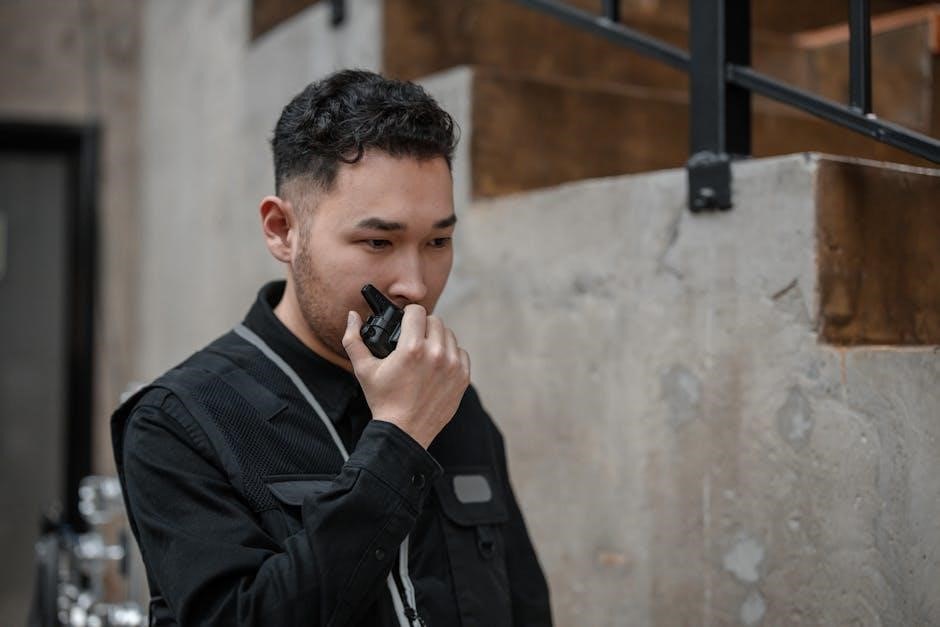The First Alert Carbon Monoxide Detector is a reliable‚ battery-operated device designed to detect dangerous CO levels in residential settings. Featuring a 10-year sealed battery‚ it provides continuous monitoring with an 85 dB audible alarm for safety. Its electrochemical sensor ensures accurate detection‚ while the digital display shows real-time CO levels. Ideal for homes‚ it includes a silence button for false alarms and low-battery warnings to ensure constant protection. This detector is an essential tool for safeguarding against the invisible threat of carbon monoxide.
Overview of Carbon Monoxide Safety
Carbon monoxide (CO) is a silent‚ odorless‚ and deadly gas produced by incomplete combustion from sources like heaters‚ generators‚ and vehicle exhaust. Prolonged exposure can cause severe health risks‚ including nausea‚ dizziness‚ and even death. CO safety is critical‚ as it can accumulate quickly in enclosed spaces. Detectors like the First Alert Carbon Monoxide Detector are essential for early detection‚ providing a lifeline by alerting residents to dangerous levels. Proper installation‚ placement‚ and maintenance of CO detectors are vital to ensure continuous protection. Understanding CO risks and implementing safety measures can prevent tragedies and safeguard lives.
Importance of Carbon Monoxide Detectors
Carbon monoxide detectors are vital for protecting lives‚ as CO is a silent‚ odorless‚ and deadly gas. These detectors provide early warnings of dangerous CO levels‚ preventing potential fatalities and injuries. CO can accumulate quickly in enclosed spaces‚ making detectors a critical safety measure. Homes with fuel-burning appliances‚ such as furnaces or water heaters‚ are at higher risk‚ and detectors ensure timely alerts. They offer peace of mind‚ especially in areas like sleeping quarters‚ where occupants may be unaware of rising CO levels. Proper installation and maintenance of detectors are essential to safeguard against this invisible threat.

Key Features of First Alert Carbon Monoxide Detectors
The First Alert Carbon Monoxide Detector features a 10-year sealed battery‚ electrochemical sensor‚ digital display‚ silence button‚ and 85 dB alarm for reliable protection and ease of use.
Digital Display for CO Levels
The First Alert Carbon Monoxide Detector features a digital display that provides real-time readings of carbon monoxide levels in parts per million (PPM). This feature ensures immediate awareness of dangerous CO concentrations‚ allowing for swift action to protect your family. The display updates continuously‚ offering precise monitoring and peace of mind. By clearly showing CO levels‚ it helps users understand when levels are rising and when it’s safe to return after an alarm. This advanced feature is available on select models‚ making it a valuable tool for enhancing home safety and ensuring prompt responses to potential threats. It’s designed for clarity and reliability.
Silence Button for False Alarms
The Silence Button on the First Alert Carbon Monoxide Detector allows users to quickly mute false alarms‚ such as those triggered by cooking fumes or steam. Located on the front of the device‚ this feature provides convenience without compromising safety. When pressed‚ it temporarily silences the alarm‚ giving you time to investigate the cause. However‚ it does not disable the detector’s ability to detect dangerous CO levels. This button is especially useful in kitchens or areas prone to non-emergency triggers‚ ensuring the alarm remains functional while reducing unnecessary disruptions. It’s a practical solution for false alarms without sacrificing protection. Always ensure the button is used correctly to maintain safety.
Low-Battery Warning System
The Low-Battery Warning System on the First Alert Carbon Monoxide Detector ensures continuous protection by alerting users when the battery level is critically low. This feature emits a distinctive chirping sound‚ providing ample time to replace the battery before the detector loses power. The warning system is crucial for maintaining uninterrupted monitoring of carbon monoxide levels. For models with a 10-year sealed battery‚ the low-battery warning indicates the end of the battery’s lifespan‚ prompting replacement of the entire unit. Always address the warning promptly to ensure the detector remains operational and your home stays protected from potential CO threats.

Weekly Testing Button
The Weekly Testing Button on First Alert Carbon Monoxide Detectors allows users to verify the device’s functionality regularly. By pressing this button‚ the detector performs a self-test‚ ensuring the sensor‚ alarm‚ and battery are operational. This simple feature provides peace of mind‚ confirming the detector is ready to respond to potential threats. Testing should be done weekly‚ as recommended‚ to maintain reliability. If the test fails‚ the detector should be replaced immediately to guarantee continuous protection against carbon monoxide hazards. Regular testing is essential for ensuring your safety and the effectiveness of the detector.
85 dB Audible Alarm
The 85 dB Audible Alarm on First Alert Carbon Monoxide Detectors ensures clear and loud alerts during dangerous CO levels. Designed to meet UL standards‚ this high-decibel alarm is loud enough to alert everyone in the household‚ even in noisy environments or for those with hearing impairments. The distinct tone is programmed to differentiate from other alarms‚ reducing confusion. When CO levels rise‚ the alarm sounds continuously until the threat is resolved. This feature guarantees prompt action‚ providing critical time to evacuate and seek fresh air. Its reliability and effectiveness make it a vital component of home safety systems.
Electrochemical CO Sensor
The Electrochemical CO Sensor in First Alert detectors is a state-of-the-art technology designed for precise carbon monoxide detection. This sensor is highly sensitive and reliable‚ providing accurate readings of CO levels in the air. Unlike other detection methods‚ electrochemical sensors are immune to interference from common household chemicals or gases‚ ensuring fewer false alarms. They operate by triggering an electrochemical reaction when CO is present‚ which activates the alarm. This technology is widely regarded as the most accurate for CO detection‚ offering early warnings and continuous monitoring to keep your home safe from this invisible threat.
10-Year Sealed Battery
The 10-Year Sealed Battery in First Alert carbon monoxide detectors provides long-lasting‚ maintenance-free protection. This battery is designed to last the entire lifespan of the detector‚ eliminating the need for frequent replacements. It ensures continuous monitoring and peace of mind‚ as you don’t have to worry about the detector losing power. The sealed design prevents tampering and accidental removal‚ while the low-battery warning system alerts you when the battery is nearing its end. This feature guarantees uninterrupted safety and ensures your home remains protected from carbon monoxide threats for years to come.
Plug-In Design with Battery Backup
The Plug-In Design with Battery Backup ensures continuous protection against carbon monoxide threats. This feature allows the detector to be powered directly from a wall outlet‚ providing consistent energy. The included battery backup kicks in during power outages‚ maintaining monitoring even when electricity is lost. Designed for ease of use‚ this system combines the reliability of plug-in power with the security of a battery. It’s ideal for residential settings‚ offering uninterrupted protection and peace of mind. The detector operates seamlessly‚ switching to battery power without any interruption in CO monitoring‚ ensuring safety at all times.

Installation Guidelines
Ensure the detector is installed in accordance with local regulations and manufacturer instructions. Choose a location central to living areas for optimal coverage and safety.
Where to Place CO Detectors
Install First Alert Carbon Monoxide Detectors on every level of your home‚ prioritizing areas near sleeping rooms and fuel-burning appliances like furnaces or water heaters. Place detectors at least 15 feet away from these appliances to avoid false alarms; Position them about 5 feet off the floor‚ as carbon monoxide spreads evenly throughout a room. Avoid installing them in areas with high humidity‚ direct sunlight‚ or extreme temperatures. Ensure detectors are within hearing range to alert occupants effectively. This placement strategy ensures comprehensive coverage and timely warnings in case of dangerous CO levels. Follow these guidelines for optimal safety and protection.
Optimal Height for Installation
Install your First Alert Carbon Monoxide Detector approximately 5 feet above the floor for optimal performance. This height ensures accurate detection since carbon monoxide spreads evenly throughout a room. Avoid placing detectors in areas with high humidity‚ direct sunlight‚ or extreme temperatures‚ as these conditions may interfere with sensor accuracy. Positioning the detector at this height also aligns with typical breathing zones‚ enhancing safety. For multi-level homes‚ install detectors on every floor to maintain consistent coverage. Proper placement at the recommended height ensures reliable detection of carbon monoxide and timely alerts for occupants.
Installation Near Sleeping Areas
Install your First Alert Carbon Monoxide Detector near sleeping areas to ensure timely alerts during emergencies. Place it on the wall or ceiling‚ about 5 feet above the floor‚ within the breathing zone. Avoid areas with high humidity or direct sunlight‚ as these can affect sensor accuracy. Position the detector near potential CO sources‚ like fuel-burning appliances. Install one on each level of your home and in every sleeping zone for comprehensive coverage. Follow local fire codes and manufacturer instructions for optimal placement. Secure the detector properly and test it after installation to ensure it works effectively. Regular maintenance‚ such as dusting and battery checks‚ is essential for reliable performance. Educate household members on the alarm’s sound and evacuation procedures to maximize safety.
Installation Near Fuel-Burning Appliances
Install your First Alert Carbon Monoxide Detector near fuel-burning appliances‚ such as furnaces‚ water heaters‚ and fireplaces‚ to monitor potential CO sources. Place the detector at least 6 feet away from these appliances to avoid direct exposure to exhaust. Ensure it is not installed in direct lines with vents or flues‚ as this could lead to inaccurate readings. Avoid areas with high humidity or direct sunlight‚ which may interfere with sensor accuracy. Install one detector per level of your home‚ prioritizing areas near sleeping zones. Follow local fire codes and manufacturer instructions for optimal placement. Regular testing ensures reliable performance and early detection of dangerous CO levels.
Step-by-Step Installation Process
Start by removing the mounting bracket from the detector. Locate the desired installation spot‚ ensuring compliance with local fire codes. Mark the wall with a pencil where the screws will go‚ then drill pilot holes if needed. Insert wall anchors into the holes and screw the bracket into place. Mount the detector onto the bracket‚ ensuring it clicks securely. Insert the sealed battery‚ making sure it’s properly aligned. Press the test button to ensure the alarm sounds; Finally‚ clean the detector with a soft cloth to remove dust. Refer to the manual for specific alignment and placement guidelines to ensure optimal performance and safety;
Mounting Bracket Alignment
Align the mounting bracket with the plastic screw anchors on the wall‚ ensuring it is level. Mark the screw holes with a pencil and drill pilot holes if necessary. Insert wall anchors into the holes and screw the bracket into place firmly. Ensure the bracket is straight and level before securing it. Proper alignment is crucial for the detector to function correctly. Once the bracket is installed‚ attach the detector by snapping it into place until it clicks. This ensures the device is securely mounted and ready for operation. Correct alignment guarantees optimal performance and safety. Always refer to the manual for precise instructions.

Testing and Maintenance
Regularly test your First Alert CO detector by pressing the test button weekly to ensure proper function. Check sensor sensitivity and clean the detector to maintain accuracy. Replace batteries as needed to prevent low-battery warnings and ensure continuous protection against carbon monoxide threats.
Weekly Testing Procedure
Press the test button on your First Alert CO detector once a week to ensure it functions correctly. This action triggers the 85 dB audible alarm‚ confirming the detector is operational. If the alarm does not sound‚ replace the detector immediately. Additionally‚ check for any error codes or low-battery warnings‚ as these may indicate a problem. Clean the detector to ensure sensor accuracy and verify that all features‚ such as the silence button‚ are working. Regular testing ensures your detector remains reliable and ready to alert you to dangerous CO levels in your home.
How to Check Sensor Sensitivity
To ensure the electrochemical sensor in your First Alert CO detector is functioning accurately‚ perform regular checks. Start by cleaning the detector to remove dust or debris that may block the sensor. Use a soft brush or vacuum cleaner to gently clean the openings. Next‚ test the detector using the weekly test button to confirm it responds correctly. If the alarm sounds as expected‚ the sensor is sensitive and functioning properly; For advanced verification‚ consult the user manual for instructions on exposing the detector to a known CO source‚ ensuring it triggers the alarm at unsafe levels. Maintaining sensor sensitivity is crucial for reliable protection against carbon monoxide threats.
Cleaning the Detector
Regular cleaning ensures your First Alert Carbon Monoxide Detector operates efficiently. Use a soft brush or vacuum cleaner to gently remove dust and debris from the exterior and sensor openings. Avoid harsh chemicals or excessive moisture‚ as they may damage the unit. For stubborn spots‚ lightly dampen a cloth with water and wipe the surface‚ ensuring no moisture enters the sensor. Never use alcohol or abrasive cleaners‚ as they can harm the electrochemical sensor. After cleaning‚ test the detector using the weekly test button to confirm proper functionality. Clean your detector every 2-3 months to maintain accuracy and reliability.
Replacing the Battery
To replace the battery in your First Alert Carbon Monoxide Detector‚ first identify the model. For detectors with a 10-year sealed battery‚ no replacement is needed until the end of the battery’s life. For models with removable batteries‚ open the battery compartment located on the back or bottom. Remove the old batteries and insert new ones‚ ensuring they are the correct type (typically AA or 9V). Align the batteries with the polarity markers for proper installation. Close the compartment and test the detector using the test button to ensure it functions correctly. Replace batteries promptly when the low-battery warning sounds to maintain protection.
When to Replace the Detector
Replace your First Alert Carbon Monoxide Detector every 10 years from the date of manufacture‚ as indicated on the product label. Over time‚ the sensor’s accuracy may decrease‚ even if the alarm still sounds. Check for signs of wear‚ such as cracks or damage‚ which necessitate immediate replacement. Additionally‚ replace the detector if it fails weekly testing or shows error codes that cannot be resolved. A functioning detector is crucial for safety‚ so never delay replacement when its lifespan or performance is compromised. Refer to the user manual for specific guidelines on replacing your model.

Troubleshooting Common Issues
Address common problems like chirping detectors by checking batteries or pressing the silence button. For connectivity issues‚ reset the device or check app connections. Refer to error codes in the manual for specific solutions. Always ensure proper installation and function to maintain safety and reliability. Regular testing helps identify and resolve issues promptly‚ ensuring your detector operates effectively at all times. Consult the user manual for detailed troubleshooting steps to address any malfunction or alert.
Why Your CO Detector is Chirping
Your First Alert Carbon Monoxide Detector may chirp due to a low battery or to signal a potential issue. Chirping is not an emergency but a warning. Press the silence button to stop the chirp temporarily. Replace the battery as indicated in the manual. If the issue persists‚ check for proper installation or sensor sensitivity. Ensure the detector is clean and free from dust. If the problem continues‚ consider replacing the unit. Always refer to the user manual for specific troubleshooting steps. Addressing the chirp promptly ensures your detector functions correctly and maintains your safety. Regular maintenance helps prevent false alarms and keeps your home protected.
How to Silence a Low Battery Warning
To silence a low battery warning on your First Alert Carbon Monoxide Detector‚ press and hold the silence button until the chirping stops. This temporarily mutes the alert‚ allowing you to address the issue without constant reminders. Replace the battery as soon as possible to ensure continuous protection. For battery-operated models‚ install a fresh battery following the instructions in the user manual. Remember‚ silencing the warning does not resolve the underlying issue. Always prioritize replacing the battery promptly to maintain your safety and the detector’s functionality. Regular checks can prevent low-battery alerts from disrupting your day.
Resolving Connectivity Issues
If your First Alert Carbon Monoxide Detector experiences connectivity issues‚ ensure it is properly connected to your Wi-Fi network. Restart your router and check your internet connection. Open the First Alert app and verify that your detector is listed under connected devices. If it’s not visible‚ reset the detector by pressing and holding the test/silence button for 10 seconds. Reconnect the device through the app‚ following the on-screen instructions. Ensure your app is updated to the latest version. If issues persist‚ contact First Alert customer support for assistance. Connectivity is crucial for smart features to function correctly‚ so resolving these issues promptly is essential for optimal performance.
Understanding Error Codes
Your First Alert Carbon Monoxide Detector may display error codes to indicate specific issues. These codes‚ often accompanied by LED patterns‚ help identify problems such as connectivity failures or sensor malfunctions. Common codes include E1‚ E2‚ or E3‚ which may signal issues like low battery‚ faulty sensors‚ or communication errors. Refer to your user manual for a detailed list of codes and their meanings. To resolve these issues‚ restart the detector‚ check connections‚ or replace the battery if necessary. If errors persist‚ contact First Alert customer support for further assistance. Understanding these codes ensures your detector operates efficiently and maintains your safety.

User Manual and Resources
Download the First Alert Carbon Monoxide Detector user manual for detailed instructions on installation‚ testing‚ and troubleshooting. The manual also includes safety tips and warranty information. Visit the First Alert website or refer to the product packaging for a downloadable PDF version. Additional resources‚ such as FAQs and customer support contact details‚ are available online to assist with any questions or concerns about your detector.
Downloading the User Manual
To access the First Alert Carbon Monoxide Detector user manual‚ visit the official First Alert website or search for the specific model (e.g.‚ CO400 or CO710) on popular manual databases. Download the PDF version for detailed instructions on installation‚ testing‚ and maintenance. Ensure to save or print the manual for future reference. The document typically includes safety tips‚ troubleshooting guides‚ and warranty information. For smart models‚ instructions for connecting to Wi-Fi and integrating with the First Alert app are also provided. Always refer to the official source to ensure accuracy and completeness of the manual.
Navigating the User Manual
The First Alert Carbon Monoxide Detector user manual is structured to guide users through installation‚ operation‚ and maintenance. It begins with safety precautions and an overview of the detector’s features. Dedicated sections cover troubleshooting common issues‚ such as chirping alarms or low battery warnings‚ and provide step-by-step solutions. The manual also includes instructions for advanced features like Wi-Fi connectivity and app integration. Diagrams and illustrations help clarify installation and testing processes. Safety tips and warranty details are highlighted to ensure optimal performance and user protection. Refer to the table of contents for quick access to specific topics‚ making it easy to navigate and understand all functionality.
Additional Safety Tips
Always ensure proper ventilation in areas with fuel-burning appliances to reduce CO buildup. Never use generators or grills indoors‚ as they emit deadly carbon monoxide. Regularly inspect fuel-fired appliances for blockages or damage. If your CO detector alarms‚ evacuate immediately and move to fresh air. Do not re-enter your home until authorities confirm it is safe. If anyone shows symptoms of CO poisoning‚ such as dizziness or nausea‚ seek medical attention promptly. Remember‚ CO is odorless and invisible‚ making a functioning detector your only warning system. Stay informed and proactive to protect your household from this silent threat.

Smart Features and Connectivity
The First Alert Carbon Monoxide Detector seamlessly integrates with smart home systems‚ offering Wi-Fi connectivity and compatibility with the First Alert app. This enables remote monitoring‚ voice alerts‚ and integration with platforms like Google Home for enhanced safety and convenience. The app provides real-time notifications‚ ensuring you stay informed about CO levels and detector status. This smart connectivity adds an extra layer of protection‚ allowing you to respond quickly to potential threats‚ even when you’re not at home.
Connecting to Wi-Fi
To connect your First Alert Carbon Monoxide Detector to Wi-Fi‚ download and install the First Alert app. Open the app and select your detector type. Ensure your device is connected to the same Wi-Fi network. Follow in-app instructions to enter your network password and complete pairing. Once connected‚ the detector will sync with the app‚ enabling remote monitoring and notifications. If issues arise‚ restart your router or check your internet connection. Successful pairing ensures seamless integration with smart home systems‚ enhancing your safety and convenience. This feature allows you to stay alerted to CO levels‚ even when away from home.
First Alert App Integration
Integrate your First Alert Carbon Monoxide Detector with the First Alert app for enhanced monitoring and control. The app allows you to receive real-time notifications for CO alerts‚ low battery warnings‚ and system status updates. Customize settings‚ such as adjusting sensitivity or setting up multiple detectors‚ directly through the app. It also enables remote monitoring‚ so you can check CO levels and detector status from anywhere. Compatible with smart home systems‚ the app ensures seamless integration for a connected safety experience. This feature provides peace of mind by keeping you informed and in control of your home’s safety‚ even when you’re away.
Smart Home Compatibility
The First Alert Carbon Monoxide Detector seamlessly integrates with popular smart home systems‚ including Google Home and Amazon Alexa. This compatibility allows voice control and remote monitoring through smart devices. Receive voice alerts for CO detections and check detector status via voice commands. The detector also works with the First Alert app‚ enabling a unified smart home security experience. This integration enhances safety by providing instant alerts and voice notifications‚ ensuring you stay informed about potential threats. Compatibility with smart home systems adds an extra layer of convenience and protection for your family.

Safety Tips and Best Practices
Never ignore a carbon monoxide alarm—evacuate immediately and call emergency services. Check for sources of CO‚ ensure proper ventilation‚ and have fuel-burning appliances inspected annually. Stay outside until authorities confirm it’s safe to re-enter. Always follow the detector’s instructions for testing and maintenance to ensure reliable protection.
Never Ignore a CO Alarm
If your First Alert Carbon Monoxide Detector sounds‚ take immediate action. Evacuate everyone from the building‚ including pets‚ and call emergency services. Do not silence the alarm or investigate the source yourself. CO is odorless‚ colorless‚ and highly toxic. Prolonged exposure can lead to severe health issues or death. After evacuating‚ stay outside until authorities confirm the area is safe. If anyone experiences symptoms like dizziness‚ nausea‚ or headaches‚ seek medical attention promptly. Remember‚ your detector is a lifesaver—never ignore its warnings. Failure to act could result in tragic consequences‚ so always prioritize safety.
Evacuation Procedures
When your First Alert Carbon Monoxide Detector sounds‚ evacuate immediately. Move everyone‚ including pets‚ to fresh air outside the building. Do not investigate the source of the alarm or try to silence it. Once outside‚ call emergency services and report the situation. Stay away from windows and doors to prevent re-entry of potential CO. Do not re-enter the building until authorities confirm it is safe. If anyone experiences symptoms like dizziness or nausea‚ seek medical help right away. Prompt evacuation is critical to avoid serious health risks. Always follow these steps to ensure everyone’s safety during a CO alarm event.
Medical Steps After CO Exposure
If you suspect carbon monoxide exposure‚ seek immediate medical attention. Symptoms like headaches‚ dizziness‚ or nausea require urgent care. Call emergency services or visit the nearest hospital. Medical professionals may administer oxygen therapy to help restore normal oxygen levels in the blood. In severe cases‚ a hyperbaric oxygen chamber may be used to accelerate recovery. Inform healthcare providers about the duration and severity of exposure. Prompt medical intervention is crucial to prevent long-term health complications‚ such as brain damage or heart issues. Always prioritize professional treatment if CO poisoning is suspected or confirmed.

Warranty and Support
The First Alert Carbon Monoxide Detector comes with a 10-year limited warranty. For support‚ contact First Alert Customer Service directly for assistance with any product-related inquiries or issues.
Product Warranty Details
The First Alert Carbon Monoxide Detector is backed by a 10-year limited warranty‚ ensuring coverage for defects in materials and workmanship. This warranty applies to the original purchaser and is non-transferable. It does not cover damage caused by misuse‚ tampering‚ or failure to follow installation instructions. For warranty claims‚ contact First Alert Customer Support directly or visit their official website for assistance. Proper registration of the product may be required to validate the warranty. This comprehensive coverage provides peace of mind‚ knowing your detector is protected for its entire operational lifespan.
Contacting Customer Support
For assistance with your First Alert Carbon Monoxide Detector‚ contact customer support via phone‚ email‚ or live chat through their official website. Support is available Monday through Friday‚ 8 AM to 7 PM EST‚ and Saturday‚ 9 AM to 3 PM EST. Visit the First Alert website for detailed contact information and a comprehensive FAQ section. Representatives are trained to address installation‚ troubleshooting‚ and warranty-related inquiries; Ensure to have your product model number and purchase details ready for faster assistance. This dedicated support team is committed to resolving issues promptly and ensuring your safety with reliable CO detection.

